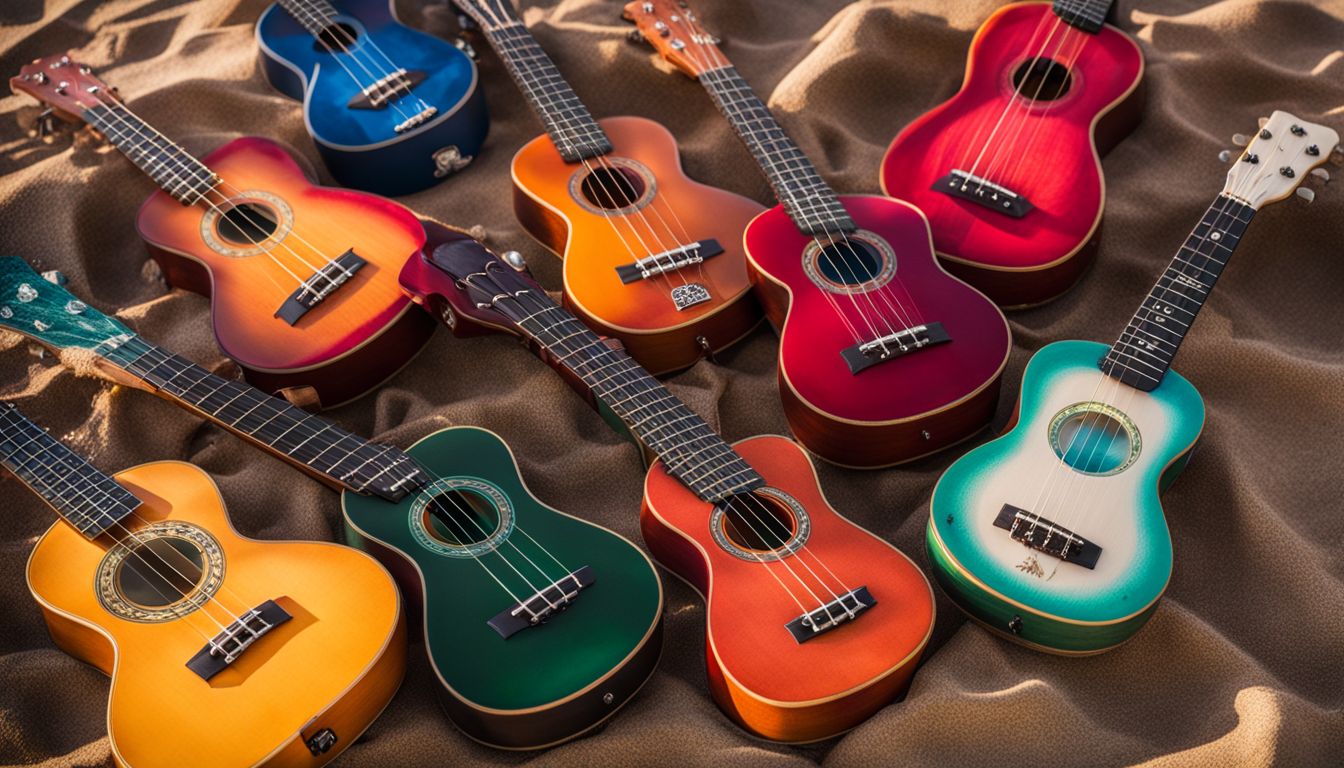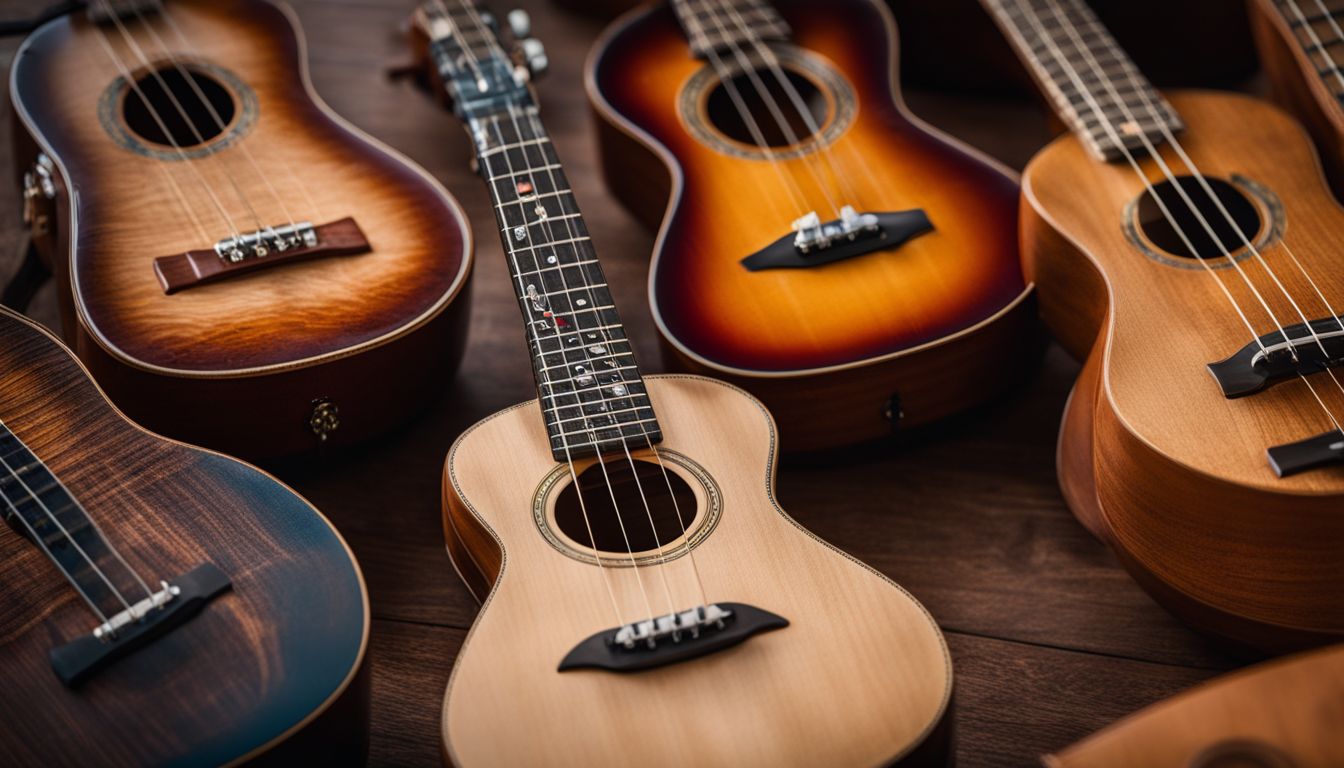
Struggling to make music with your new ukulele? It’s a fun little instrument that’s big on charm and gaining fans worldwide. Our ‘Ukulele 101’ guide will lay down the basics, from chords to care, helping you strum your first tune confidently.
Let’s get plucking!
Key Takeaways
- Master the basic chords like C, G, Am, F and practice changing between them smoothly to play a wide range of songs on your ukulele.
- Experiment with different strumming patterns and learn to strum down – up or try the “island strum” for that unique ukulele rhythm.
- Choose the right size ukulele for you, such as soprano for classic tones or tenor for fuller sounds; consider wood types like koa or mahogany for desired tonal qualities.
- Explore reputable brands like Kala, Mahalo, and Lanikai when purchasing your first ukulele—they are known for quality instruments suitable for beginners.
- Develop essential techniques such as proper tuning (standard G-C-E-A), effective strumming and picking, which will enhance your playing skills over time.
What are the basic ukulele chords for beginners?

Starting your ukulele journey begins with mastering a few essential chords that form the backbone of countless songs. These foundational grips are simple to learn and open up a world of musical possibilities for budding ukulele enthusiasts.
Chord progression for popular songs

Chord progressions form the backbone of many hit tunes. They can turn a few simple chords into a memorable song.
- Start with the basics: C, G, Am, and F. This classic combination is used in countless songs and is easy for beginners to learn.
- Practice changing between these chords smoothly. Good transitions will make playing songs easier and more enjoyable.
- Add a strumming pattern to these chords. Try down-strokes on beats one and three and upstrokes on two and four for rhythm.
- Explore the G, Em, C, and D progression. It’s another popular sequence featured in many modern hits.
- Learn to play the E minor chord. Adding Em to your repertoire opens up more possibilities for song playing.
- Try the A minor to F transition. It’s common in verses for numerous ballads and pop songs.
- Include the D minor chord in your practice routine. It brings a somber tone that suits many genres like blues and folk.
- Familiarize yourself with B flat (Bb). Although it may be challenging at first, it’s essential for jazz-influenced music.
- Master moving from G7 to Cmaj7. This jazzy progression adds sophistication to your ukulele sound palette.
- Experiment with adding sus4 or sus2 variations to basic chords. These subtle changes can give songs a unique feel.
Learning and mastering easy chord transitions

Jumping between chords smoothly is a crucial skill for ukulele players. It allows you to play songs seamlessly and adds confidence to your performance. Here’s how to learn and master easy chord transitions:
- Begin with two simple chords, like C7 and F, and practice switching between them slowly. Increase your speed as you get comfortable.
- Focus on the movement of each finger individually, making sure they know where to go next.
- Use a metronome to keep a steady pace while practicing chord changes; this will help develop your timing.
- Try different strumming patterns as you switch chords to challenge your coordination and versatility.
- Master one pair of transitions before adding another chord into the mix, such as G7, creating a three-chord progression.
- Look for common finger positions shared by chords and use these as anchor points for faster changes.
- Practice little and often; frequent short sessions are more effective than rare long ones for muscle memory development.
- Keep your hand relaxed to prevent stiffness; tension can slow down transition speeds.
- Gradually work on more complex chords once the basic transitions feel natural and easy.
- Record yourself playing to identify areas that need improvement and track your progress over time.
Strumming patterns to accompany chords

Strumming patterns bring life to the chords you play on your ukulele. They add rhythm and can express different emotions in a song. To start, master a simple down-up pattern; this means you strum down with your finger or pick towards the floor, then up towards the sky.
Practice keeping a steady tempo and gradually increasing speed as you get more comfortable.
Experiment with various strumming techniques to find what works for each song. A common pattern is the “island strum,” which goes like this: down, down-up, up-down-up. It fits well with many tunes and creates that breezy tropical feel that’s signature to ukulele music.
As you explore these rhythms, pay attention to how they complement chord progressions and enhance musical genres ranging from pop to folk.
Understanding different chord variations will be your next step in advancing your ukulele skills.
Understanding different chord variations

Chord variations can take your ukulele playing to new heights and add richness to the songs you play. As you dive into different music genres, expanding your chord vocabulary becomes essential.
You’ll encounter chords with added sevenths, minors, and even diminished or augmented notes that create unique sounds and emotional tones. For instance, while a C major chord is bright and happy, a C minor chord might express a more reflective or somber mood.
Mastering these variations broadens your musical expression and equips you to tackle diverse styles from upbeat pop melodies to bluesy rhythms with ease. Experimenting with different finger positions on the fretboard allows for subtle changes in harmony that can make familiar tunes feel fresh again.
And as you continue practicing these varied chords, transitioning between them will become smoother, increasing both your confidence and performance flair when showcasing your skills on the ukulele.
Expanding chord vocabulary for diverse music genres

Mastering different chord variations opens the door to a world of musical possibilities. To truly capture the essence of various music genres on your ukulele, expanding your chord vocabulary is essential.
Dive into jazz with its rich seventh and extended chords or bring out the soulful melodies in blues through dominant and minor chords. Country tunes often rely on major and suspended chords, adding that heartfelt twang.
Meanwhile, rock songs might call for power chords and barre grips to create their iconic driving sound.
Learn special strumming techniques alongside these new chords to enhance each genre’s distinct rhythm. Try palm muting for reggae beats or fast downstrokes for punk anthems. Experimenting with fingerpicking patterns can also add depth to folk songs or flamenco pieces.
As you grow your repertoire across different styles, you’ll find certain chords are versatile, while others offer that genre-specific flair that’s sure to impress listeners. Embrace this exploration as part of your journey; it will not only boost your playing skills but also enrich your overall musical experience.
How to choose the right ukulele for a beginner?

Selecting the ideal ukulele as a beginner can set the stage for an enjoyable learning experience. It’s about matching your musical aspirations with an instrument that feels comfortable in your hands and sounds pleasing to your ears.
Understanding the different types and sizes of ukuleles

Ukuleles come in a variety of types and sizes, each with its unique sound and playability. Soprano ukuleles are the smallest, offering a classic bright tone that’s ideal for traditional Hawaiian music.
Concert ukuleles provide a slightly larger option with richer sound, perfect for those who want more volume and finger room. Tenor ukuleles deliver an even fuller tone and longer scale, preferred by professional musicians for their versatility across various music styles.
For bass tones similar to an acoustic bass guitar, baritone ukuleles are the largest size commonly available.
Choosing among these options depends on personal preference, hand size, and musical needs. A beginner might start with a soprano or concert ukulele due to their manageable sizes and affordable prices.
As one progresses in skill level or seeks different tonal qualities, exploring tenor or baritone models could enhance playing experience. Next up is looking into the wood types used in constructing these instruments—another key factor affecting your ukulele’s overall sound signature.
Exploring the tonal qualities of various wood types

Transitioning from the physical aspects of ukuleles, let’s delve into the acoustic properties that different woods bring to the instrument. The wood used in constructing a ukulele greatly influences its sound.
Mahogany, known for its warmth, delivers a mellow tone perfect for blues or folk. Koa wood hails from Hawaii and offers a bright, rich sound that’s synonymous with traditional Hawaiian music.
Cedar tops impress with their loud and full-bodied resonance—ideal for fingerstyle players seeking clarity in lower tones.
Spruce is another popular choice; it provides crisp and articulate notes making it suitable for lively strumming. Maple rounds out the options with a focused, punchy quality that cuts through mix effortlessly – excellent if you play in a band setting.
Each type of wood not only contributes to your ukulele’s aesthetic but also shapes your musical expression by accentuating certain styles better than others. Whether you’re drawn to soft melodic lines or upbeat rhythmic patterns will guide you toward finding the appropriate ukulele with the tonal qualities that resonate best with your personal preferences.
Finding the appropriate ukulele for specific music styles

Different music styles often require unique sounds, and the ukulele you choose can have a huge impact on your musical expression. If you’re into traditional Hawaiian music, a standard soprano with its classic bright tone is perfect for getting those sweet, soft melodies.
For blues or jazz, where a fuller sound is desirable, consider tenor or baritone ukuleles which offer deeper tones and more volume.
Playing folk or pop songs? A concert ukulele might be your best bet because it blends portability with a rich sound that carries well in group settings. The wood type also plays a critical role: Koa wood brings warmth to your tunes while mahogany projects clarity.
Keep these factors in mind alongside reputable brands like Ohana, Kala, and Lanikai when picking out the ideal ukulele for your music journey.
Factors to consider when purchasing a beginner ukulele

Choosing your first ukulele is an exciting step towards making music. It’s important to select an instrument that feels right to you and will support your learning journey.
- Size Matters: Ukuleles come in various sizes, including soprano, concert, tenor, and baritone. A soprano or concert ukulele is often recommended for beginners due to its manageable size and classic sound.
- Type of Wood: The wood type influences the tone of the ukulele. Options like mahogany offer warm tones, while koa wood provides a rich Hawaiian sound. Consider the tonal qualities you prefer before making a decision.
- Playability: Ensure the ukulele has comfortable action—the distance between the strings and the fingerboard. Lower action can be easier on the fingers for new players.
- Craftsmanship: Look for solid construction. Joints should be tight and finish smooth with no visible rough edges or excess glue.
- Sound Quality: Play or listen to several models to find one with a pleasant tone that resonates with you; this keeps you motivated to practice regularly.
- Brand Reputation: Research reputable ukulele brands for beginners who are known for good-quality starter instruments, such as Kala, Lanikai, and Mahalo. These brands are reliable choices for durability and sound quality.
- Included Accessories: Some beginner ukuleles come with helpful extras like gig bags, tuners, or beginner guides. Packages like these offer great value and convenience.
- Budget Considerations: Establish your budget beforehand, but don’t necessarily go for the cheapest option; investing in a slightly better model can enhance playability and enjoyment.
- Tuning Pegs: Make sure tuning pegs are easy to turn yet hold their tune well. This helps maintain proper pitch and makes tuning less frustrating for new players.
Recognizing reputable ukulele brands for beginners

Once you’ve considered the various factors for your first ukulele, it’s time to look at brands that are known for quality and beginner-friendliness. Kala and Mahalo are two of the most prominent names in the world of ukuleles, offering a range of instruments that cater well to newcomers.
Their models are praised for being easy to play, which is crucial as you’re learning chords and techniques. Lanikai is another brand that deserves attention; they make affordable yet reliable ukuleles perfect for starting on the right note.
Luna’s beautifully crafted designs not only provide visual appeal but also produce rich sounds that can inspire any beginner player. Look out for their starter kits, which often include necessary accessories like a tuner and carrying case – invaluable tools when maintaining your instrument and enhancing its longevity.
Donner and Cordoba offer excellent options too; these brands have built a reputation for crafting durable ukuleles with clear tones that help new players easily distinguish notes as they practice strumming patterns and melodies.
Size, Strings, and Wood

Diving into the world of ukuleles reveals how size, strings, and wood choice play pivotal roles in shaping your instrument’s unique sound. Whether it’s the deep warmth of a baritone or the classic twinkle of a soprano, these elements are key to finding a ukulele that resonates with your personal musical style.
How they affect the sound of the ukulele
The size of a ukulele greatly influences its sound. Soprano, concert, tenor, and baritone ukuleles each produce distinctive tones because of their different scales and body sizes. A smaller soprano will have a brighter tone while the larger baritone offers deeper resonance.
The material of the strings is another essential factor that shapes the instrument’s voice. Nylon strings tend to deliver a softer and warmer sound compared to steel strings which are louder and have more brightness.
Wood type also plays a crucial role in the tonality of your ukulele. Different woods resonate with varying qualities; for instance, mahogany typically yields a warm tone with an emphasis on mid-range frequencies.
On the other hand, koa wood is known for its rich highs and lows which contribute to a fuller sound signature typical of Hawaiian-style playing. Your choice in wood not only affects volume but it can bring out subtleties that give character to every note you play on your ukulele.
Choosing the right ukulele for you
Selecting the perfect ukulele is key to your musical journey. Consider these factors to find an instrument that resonates with your style and preferences.
- Assess different ukulele sizes, such as soprano, concert, tenor, and baritone, to find one that fits comfortably in your hands.
- Explore the sound qualities of ukuleles made from various woods like koa, mahogany, and spruce; each type offers unique tonal characteristics.
- Check the tension and action of the strings on potential ukuleles to ensure they are comfortable for playing long sessions.
- Understand that strings can be made from different materials which will affect sound and playability; try out a few types if possible.
- Examine the craftsmanship of each ukulele, ensuring it has smooth frets, a sturdy bridge, and reliable tuning pegs for sustained quality.
- Research reputable brands known for producing quality beginner instruments to make a smart purchase decision.
- Use online resources to read reviews and compare prices before buying your first ukulele.
- Listen carefully when testing ukuleles; trust your ears since the instrument should sound pleasant to you above all else.
- Test drive several models at music stores or through borrowing from friends or clubs; hands-on experience will guide you towards the best choice.
- Consider how the size of the ukulele affects its portability if you plan on traveling with it frequently.
What are the essential techniques for beginner ukulele players?

Diving into the world of ukulele, beginners will find that mastering a few essential techniques can make all the difference. From perfecting your tuning to getting comfortable with basic strumming and picking, these foundational skills pave the way for playing enchanting melodies and captivating songs.
Learning how to tune the ukulele properly
Tuning your ukulele is a crucial step before playing any song. It ensures the notes and chords sound harmonious and are pleasant to the ear. Here’s how to get your ukulele sounding just right:
- Start by familiarizing yourself with the standard tuning for most ukuleles, which is G-C-E-A. Each letter represents the note that each string should produce when plucked open.
- Purchase a digital clip-on tuner, an easy tool for beginners. Attach it to the headstock; it will read vibrations to tell you which note each string is tuned to.
- Turn on your tuner and pluck the top G string (4th string). Watch the display settle on a letter; turn the tuning peg until it reads “G”.
- Repeat this process with C (3rd string), E (2nd string), and A (1st string), adjusting each tuning peg until you get a clear, accurate note.
- Check each string several times as changing one can slightly alter the pitch of others.
- Practice tuning by ear over time by comparing your strings to a piano or an online reference pitch—this sharpens your musical ears too!
- Ensure your ukulele stays tuned longer by stretching new strings. Gently pull them away from the fretboard and then retune.
Developing effective strumming and picking techniques
Mastering the ukulele involves developing strong strumming and picking skills. These techniques lay the foundation for playing simple melodies and songs for beginners.
- Hold the pick lightly if you’re using one, or learn to strum with your fingers. Your thumb or fingers should gently brush across the strings.
- Practice different strumming patterns to find the one that feels most natural. Start with a simple down-up pattern before moving on to more complex rhythms.
- Work on keeping a steady tempo as you strum. Use a metronome app or click track to help maintain consistent speed.
- Focus on wrist movement for strumming rather than arm movement. This helps develop control and finesse in your technique.
- Begin with basic chord shapes and practice transitioning between them while maintaining your strumming pattern.
- Learn to mute strings with your palm to create a percussive effect. This adds variety and dynamics to your playing style.
- Incorporate fingerpicking into your practice sessions by plucking individual strings in sequence. It’s essential for playing arpeggios and melody lines.
- Develop coordination between your fretting hand and picking hand through slow, deliberate practice sessions.
- Experiment with different string tensions by pressing harder or softer on the fretboard, observing changes in tone and volume.
- Use online resources such as tutorial videos to see various strumming and picking techniques in action. This can accelerate your learning process.
- Attend beginner-friendly ukulele courses that offer step-by-step guidance in person or virtually, providing personalized feedback on your technique.
- Join local ukulele clubs where you can watch experienced players and get tips on improving your own techniques.
Playing simple melodies and songs for beginners
Playing simple melodies and songs is a great way for beginners to enjoy the ukulele. These tunes usually involve just a few chords and straightforward strumming patterns.
- Start with single-note melodies. Play familiar tunes like “Twinkle Twinkle Little Star” using only one finger at a time.
- Practice easy songs that use basic chords. “You Are My Sunshine” is an excellent example, commonly using C, G, F, and Am chords.
- Learn chord transitions by repeating them. Go from C to G to F until the movement feels natural and smooth.
- Use down-strumming for a clear sound. Many beginner songs sound good when you strum downward on the beat.
- Incorporate up-strums as you get comfortable. Strumming both up and down adds rhythm and variety to your playing.
- Experiment with different strumming speeds. Playing slowly helps accuracy; speeding up can make it more challenging.
- Simplify complex songs into easier versions. Find or create arrangements of your favorite tunes with fewer chords.
- Keep a steady tempo while practicing. Consistency is key to making melodies sound fluid and cohesive.
- Utilize online resources for tabs and tutorials. Websites often have beginner-friendly versions of popular songs tailored for ukulele.
- Attend local ukulele classes or workshops if available. Guidance from an instructor can speed up your learning process.
- Join ukulele communities online or in-person for support. Other players can offer tips, encouragement, and song recommendations suitable for beginners.
Utilizing beginner-friendly online resources and courses
Once you’ve got a handle on simple melodies, the next step is to dive into the wealth of beginner-friendly online resources and courses. These digital platforms offer interactive lessons that can guide you through each aspect of playing the ukulele at your own pace.
They often include video tutorials where you can watch experienced players demonstrate techniques, which is a great way to improve finger dexterity and coordination.
These courses also provide structured learning paths, making it easier to track your progress. You’ll find plenty of exercises designed to enhance your skills gradually while keeping practice fun and engaging.
Online communities connected with these resources can be invaluable for getting feedback, encouragement, and tips from fellow ukulele enthusiasts who are also on their musical journey.
Improving finger dexterity and coordination through practice
As you tap into online resources and courses to learn the ukulele, practice will be your best friend for boosting finger dexterity and coordination. Exercises like scales, arpeggios, and chord transitions are fundamental in training your fingers to move quickly and accurately across the fretboard.
Start slow to build muscle memory, then gradually increase speed as you get more comfortable with the movements.
Playing daily—even if it’s just for a few minutes—makes a big difference in how swiftly your fingers adapt to new chords and strings. Finger stretching exercises can also improve flexibility, making it easier for you to reach notes that initially seem tough.
Consistent practice not only polishes your technique but also prepares your hands for more complex ukulele pieces down the road.
Thumb strumming technique
Building on your finger dexterity and coordination, the thumb strumming technique offers a whole new layer of sound to your ukulele playing. This method involves using the pad of your thumb to gently sweep across the strings, creating a soft, mellow tone that’s ideal for slower songs or warm-up exercises.
Your thumb can move either down or up across the strings, giving you control over volume and rhythm.
Master this technique by starting with a relaxed hand position. Ensure your thumb strikes each string evenly, producing clear notes without any buzzing or muted sounds. Practice switching between quick strums for upbeat tunes and slower sweeps for more contemplative pieces.
With consistent practice, thumb strumming will become second nature and add depth to your musical repertoire.
LEARN MORE: Thumb Technique On Ukulele
First chords (C7, F, G7)
Diving into your ukulele journey, the first chords to conquer are C7, F, and G7. These three are the backbone of countless songs and a great place to start. The C7 chord is as simple as placing one finger on a single string – it’s perfect for beginners! Mastering the F chord will require two fingers, but with practice, you’ll get there in no time.
The G7 might seem tricky at first since it needs three fingers to spread over different strings; however, once you’ve got these down, playing songs will become much easier.
Next up, after nailing these chords, is learning how to maintain and care for your ukulele so that it stays in top-notch condition while you play beautiful music.
How to maintain and care for a ukulele?

To ensure your ukulele sings sweetly for years to come, a little TLC in the form of routine care and maintenance is key—discover the harmonious secrets within.
Proper storage and handling to prevent damage
Taking care of your ukulele means more than just playing it; proper storage is key. Handling your instrument with care can prevent damage and prolong its life.
- Keep your ukulele in a case when not in use. A soft or hard case protects it from dust, moisture, and accidental bumps.
- Store the ukulele in a stable environment. Avoid places with high humidity or extreme temperatures, which can warp the wood and affect tuning.
- Hang it on a wall mount designed for instruments. This keeps your ukulele out of harm’s way while displaying it safely.
- Avoid leaving your ukulele on the ground. Someone might step on it or trip over it, causing damage to both the person and the instrument.
- Handle your instrument by holding the neck close to the body. This provides support and prevents strain on the neck joint.
- Clean your hands before playing. Oils and dirt from your fingers can transfer to the strings and wood, leading to wear over time.
Regular cleaning and maintenance routines for ukuleles
Keeping your ukulele in great shape involves regular care and maintenance. Proper cleaning and upkeep ensure it always sounds its best and prolongs the life of your instrument.
- Start by gently wiping down the body and neck of your ukulele with a soft, dry cloth to remove dust and fingerprints.
- Use a slightly damp cloth to clean tougher spots or grime but avoid getting moisture on the strings or inside the ukulele.
- Inspect the strings for signs of wear or corrosion and replace them as needed to maintain sound quality.
- Tighten any loose tuning pegs with a suitable screwdriver, ensuring they are firm to keep your ukulele in tune.
- Polish the wood with a designated fretboard oil or conditioner, but use these products sparingly to prevent buildup.
- Store your ukulele in a case or gig bag when not in use to protect it from dust, humidity changes, and accidental damage.
- Check the action regularly—the height of the strings above the fretboard—to make sure playing is comfortable. Adjust if necessary using proper tools or consult a professional.
- Keep an eye on the humidity where you store your ukulele; too much or too little can warp the wood over time. Use humidifiers or dehumidifiers if required.
- Periodically give your ukulele a thorough inspection for any cracks, dents, or other damage that could affect playability.
- Consider using a tuner frequently to check that each string is at the correct pitch, especially before playing sessions or practices.
Replacing ukulele strings and understanding string types
Following a diligent cleaning and care routine, it’s equally important to know how to replace ukulele strings when they wear out or break. Fresh strings can breathe new life into your instrument, making your music sound brighter and more resonant.
Start by selecting the right type of string for your ukulele; options include nylon, fluorocarbon, and wound metal strings. Each material affects tone differently—nylon produces a warm, classic uke sound, while fluorocarbon offers a brighter punch.
Once you’ve chosen your string type, make sure you have the necessary tools on hand—a tuner is essential for getting each string up to pitch after installation. Don’t rush the process; carefully thread each string through its corresponding tuning peg and bridge hole, then gradually increase tension using the tuners until you reach the correct pitch.
Over time as you fine-tune this skill, adjusting ukulele tension will become second nature and help ensure optimal playability of your beloved instrument.
Adjusting ukulele tension and action for optimal playability
Getting your ukulele to sound great involves adjusting the tension and action. This ensures it’s comfortable to play and produces a clear tone.
- Start by checking the string height, known as action, at the 12th fret. It should be high enough to avoid buzzing but low enough for easy playability.
- Use a ruler to measure the action at both the 12th fret and near the nut. Typical actions are around 1/8 inch (3mm) at the 12th fret.
- If adjustments are needed, carefully turn the truss rod with an appropriate tool. This controls neck bend and affects string height.
- Tighten the rod to lower action or loosen it to raise the action, but only make quarter-turn adjustments at a time.
- Always ensure your ukulele is tuned before testing the action. This affects neck tension and can change how strings vibrate.
- Examine the nut slots; they shouldn’t grip or pinch strings. Slots too tight can cause tuning issues.
- Gently file nut slots if necessary, ensuring not to cut them too deep, which can create extra buzz.
- Inspect saddle height; this also impacts playability. The saddle is replaceable if it’s too low or high.
- Choose the correct gauge strings for your preferred tension. Thin strings have lower tension than thicker ones.
- Replace old strings regularly as worn strings can affect both tension and sound quality.
- Utilize trusted tuners and maintenance tools for accurate adjustments on your ukulele.
Utilizing tuners and tools for accurate tuning and maintenance
Playing your ukulele in tune is crucial for a great sound. Proper use of tuners and maintenance tools keeps your instrument performing at its best.
- Begin by selecting a reliable ukulele tuner. Clip-on headstock tuners are popular since they are easy to use and can accurately sense the instrument’s vibrations.
- Check the tuning before every practice session. This ensures that you get accustomed to how the chords should sound when played correctly.
- Use a chromatic tuner for more precise tuning, especially if your ukulele has non-standard tuning.
- Familiarize yourself with the standard ukulele tuning notes: G, C, E, A. Each string corresponds to one of these pitches moving from top to bottom.
- Regularly replace old strings, as they can lose their integrity and affect the overall tune. New strings often require frequent retuning until they stretch out and settle.
- Learn how to wind new strings onto the tuners properly. Secure winding ensures stability in tuning.
- Maintain proper humidity levels where you store your ukulele, as extreme conditions can warp wood and affect tuning stability.
- Adjust the tightness of the tuner gears if you notice slippage or difficulty in turning; it impacts how well the ukulele holds its tune.
- Keep a small tool kit with essential items such as a string winder, microfiber cloth, and screwdriver for routine upkeep.
- Invest time in learning about intonation – how well notes stay in tune up and down the fretboard – as poor intonation can make even a correctly tuned string sound off pitch when fretted.
What are the next steps after mastering the basics of ukulele playing?

Once you’ve got the basics down, it’s time to elevate your ukulele game, diving into intricate techniques and broader musical horizons that await your newfound skills.
Exploring advanced ukulele techniques and playing styles
Diving into advanced ukulele techniques opens up a new realm of musical expression. Mastering different playing styles will set you on a path to becoming a versatile musician.
- Experiment with fingerpicking patterns to create intricate melodies and rhythms. This method involves using your fingertips or nails to pluck individual strings instead of strumming.
- Practice playing arpeggios, where the notes of a chord are played in succession rather than simultaneously. It adds texture to your music and is great for solo performances.
- Incorporate slides, hammer-ons, and pull-offs in your playing. These legato techniques help you transition between notes smoothly and add flair to any song.
- Learn how to mute strings with your strumming hand to create a rhythmic, percussive effect that can enhance your playing with dynamic beats.
- Study various strumming styles, such as the triplet strum or syncopated rhythms, that can make even simple songs sound more complex and engaging.
- Explore the use of harmonics on the ukulele by lightly touching certain points on the string while you pluck or strum. This technique produces bell-like tones for special accents in music.
- Delve into genre-specific styles by learning Hawaiian slack-key techniques or incorporating elements from jazz, blues, or flamenco into your ukulele playing.
Joining ukulele clubs and communities for musical growth
Joining a ukulele community or club can be a game-changer for your musical journey. These groups offer a supportive environment where you can share tips, learn new songs, and get feedback on your playing.
You’ll find members ranging from beginners to experienced players, all eager to strum along and help each other improve. Engaging with a community gives you access to a wealth of knowledge that can only come from fellow enthusiasts who live and breathe ukulele music.
Participating in performances and ukulele jam sessions is another great way to build confidence and take your skills to the next level. Playing with others allows you to experiment with different rhythms, learn how to harmonize, and broaden your musical ear.
Plus, jamming in a group will challenge you to keep up with various tempos and styles, pushing you out of your comfort zone which is crucial for growth as an artist. Whether it’s practicing chords or dissecting intricate fingerpicking patterns together, there’s always something new happening at these gatherings that will inspire you to expand your repertoire.
Participating in performances and ukulele jam sessions
Taking your ukulele skills beyond club meetings, stepping onto a stage or joining in on jam sessions can be both thrilling and educational. Live performance offers an invaluable opportunity to grow as a musician—whether you’re playing for the first time in front of an audience or you’re a seasoned player looking for a new challenge.
You’ll learn how to handle nerves, project your music, and connect with listeners. Plus, jam sessions are perfect for improvisation and experimenting with different musical styles.
Sharing tunes with fellow ukulele enthusiasts not only boosts your confidence but also expands your repertoire of songs. It pushes you out of your comfort zone and into a space where feedback flows freely; this is essential for sharpening those strumming techniques and learning the nuances that make each song unique.
As you perform more regularly, consider taking on songs that are intermediate to advanced—a surefire way to keep the learning process exciting!
Expanding repertoire with intermediate to advanced ukulele songs
Expanding your song repertoire takes your ukulele skills to new heights. Dive into intermediate and advanced songs for a challenging yet rewarding musical journey.
- Start exploring songs that involve more complex chord progressions, stepping beyond the fundamental four-chord tunes.
- Practice pieces with quicker tempo and intricate strumming patterns to improve your timing and coordination.
- Tackle songs requiring fingerpicking techniques to add a delicate touch and enrich the melody of your play.
- Master the use of barre chords to unlock an even wider range of songs typically reserved for advanced players.
- Incorporate slides, bends, and hammer-ons into your playing for expressive phrasing commonly found in blues or rock genres.
- Learn how to transpose songs into different keys, expanding the variety you can play regardless of vocal range or preference.
- Engage with instrumental ukulele compositions that highlight the instrument’s unique capabilities without vocal accompaniment.
- Delve into the great works of famous ukulele players like Jake Shimabukuro to understand high-level playing styles and interpretations.
- Set personal challenges by learning one new intermediate or advanced song each week to steadily grow your song library.
Considering progression to other ukulele sizes and playing levels
As you build confidence with a broader song selection, you might feel ready to explore different ukulele sizes and playing levels. Stepping up from a beginner’s soprano ukulele to concert or tenor varieties can be rewarding and challenging.
These larger instruments offer a richer sound and more frets, ideal for complex chords and advanced techniques.
Choosing to move onto a baritone ukulele could intrigue players looking for depth in tone similar to that of a guitar, while still keeping the ukulele’s charm. For those committed to growth in their musical journey, mastering various types of ukuleles sharpens skills and opens new avenues for expression.
Pushing your boundaries by attempting difficult pieces on these diverse instruments can lead to significant improvements in dexterity and playing sophistication.
Conclusion

Dive deeper into your musical journey with the ukulele, embracing its growing popularity and discovering a world of resources that await your strumming adventure.
Resources for further learning
Take your ukulele skills to the next level with a plethora of online tutorials and interactive courses designed for players at every stage. Websites like YouTube offer endless free lessons that cover everything from basic chords and strumming techniques to complex fingerstyle songs.
Seek out virtual classes or even attend local workshops; both provide structured environments where you can ask questions, receive feedback, and learn alongside fellow enthusiasts.
Consider joining a ukulele community or club where you can share tips with other players and find motivation in group practice sessions. Many communities organize meetups and events tailored to all skill levels, ensuring you have fun while continuing your musical journey.
Such social experiences often lead to learning new songs faster while embracing the joy of playing music with others.
The rising popularity of the ukulele
The ukulele is taking center stage in music communities worldwide. Its compact size and melodious sound have captivated players of all ages, leading to a surge in sales and lessons.
With its easy-to-learn chords and versatile nature, the instrument has found a home in classrooms, online tutorials, and local jam sessions alike. Celebrities strumming on social media have also boosted its appeal, inspiring fans to grab a ukulele and join the trend.
Accessibility plays a key role in the ukulele’s widespread acclaim. Unlike many instruments that require significant investment and space, beginners can easily afford and store even high-quality models from recommended brands for beginners.
Music festivals now often feature ukulele stages where enthusiasts gather to share tips for beginner ukulele players and celebrate this unassuming yet powerful four-stringed phenomenon.
FAQs
1. What exactly is a ukulele?
A ukulele is a small, stringed instrument that you can strum or pick to make music, and it has a unique sound that’s different from guitars.
2. Can you explain the anatomy of a ukulele?
Sure! The anatomy of a ukulele includes parts like the body, neck, strings, frets which all work together to create its signature sound when you play it.
3. What’s the proper way to hold and fret a ukulele?
To hold and fret the ukulele right: keep it snug against your body, use your left hand to press down on the strings along the frets, and strum with your right hand.
4. How do I get started learning to play?
You can start by attending a beginner’s lesson or class where they’ll teach you basics; plus joining a community or club for more fun while practicing with others!

